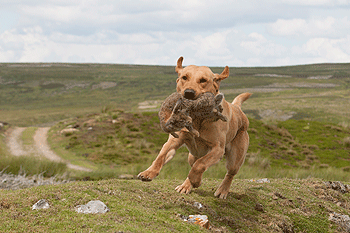Rabbiting: A walked-up run

The Castle Bolton Estate nestles high in the North Yorkshire Dales, in spectacular scenery. Well known for its excellent grouse and pheasant shooting, over the past few years the estate has started to develop “rabbit training days” for both retrievers and spaniels.
Rabbits can cause significant damage to the heather moorland, especially on the fringes, and their control is part of the estate’s ongoing heather regeneration programme, especially in areas where re-seeding is planned. Traditional methods such as drop-boxes and lamping help to keep numbers down, but the estate has realised that the rabbits can bring an additional income while helping to support gundog work. Headkeeper Ian Sleightholm is responsible for running the training days along with Andrew Robinson of Whaupley Gundogs, and with more than 14,000 acres of heather, bracken banks, rushes and white grass, the terrain is ideal for all gundog breeds.
We joined Peter Bates of Levenghyl Labradors and his group of both experienced field triallers and novice handlers as they ran a mixture of Labradors and golden retrievers. Peter is an A-panel field trial judge who has qualified for the IGL Retriever Championship 10 times. He explained that there are many benefits to these rabbit training days — one of them being that they can be held during the summer months, while for novice dogs that are ready to enter their first shooting season, it provides the chance to experience the atmosphere of a shoot day in a controlled situation. For a retriever, walking to heel in a line while a busy spaniel thrashes around in rough grass or bracken helps to build mental stamina and concentration — skills that a dog must develop if it is to go on to compete in field trials.
Peter also uses these days to train dogs and handlers in what he calls “running the line”. On a walked-up shoot day, the Guns and handlers walk in a line, and it is vital that that line remains straight — not only for safety, but also so that everybody can see any game that is shot and the dogs can get a good mark on it. In most cases, if something is shot, the dog at the farthest end of the line is sent, giving distance to the retrieve. Ideally, the dog should run tight to the line of Guns and other handlers until it hits the shot scent, which should draw it to the fall area and then on to the game. Peter explained that, if the dog runs at a slight angle away from its handler, and the line is long — as it can be at the championships — by the time it reaches the Gun that took the shot, it could be as much as 50m to 60m out from the line and on the wrong side of the retrieve.
Resisting temptation
The rabbits were sitting tight, and on a couple of occasions the handlers put up a squatting rabbit. This was tempting for the dogs, but it was all part of their training. Kirsty Cousins, an experienced handler, tries to attend as many of these training days as she can before the shooting season starts, and she was running both novices and older dogs. Kirsty believes that it is important to be able to train a young dog in a controlled situation, especially in circumstances where a retrieve may not be successful in the first instance, and then the same scenario can be set up again until the dog gets it right and thus learns from its mistakes. She also emphasised the importance of teaching a dog patience when walking in line, and promoting steadiness to both shots and the flushing of rabbits, whether close or far away.
Another key element is teaching the dog to “take a line”. A rabbit will leave a scent trail as it bolts, and coupled with the shot scent, this means that the dog will have to get its nose down on the ground to find the retrieve. This is a vital skill that will enable the dog to find any pricked birds during the shooting season.
Margaret Pearce was running her 18-month-old black Labrador Woodsprite Druid of Esmoro (Baker) for the first time on a live shoot day, providing the chance for his first warm retrieve. Margaret was slightly apprehensive, but as we set off, a couple of rabbits were shot behind the line and Peter asked her to send Baker. It was clear that Margaret had been thorough in the dog’s basic training because he went out and picked the first rabbit with no problem and had made a good mark on the second.
Temptation was all around for the young dogs. The two Guns present had two busy little spaniels working the rushes, often working in front of the retrievers, and when they went into patches of heather, rabbits were flushed in sight of the dogs. It was a credit to all the handlers that, over the two days, not one of the dogs ran in on either the flush or the shot, and therein lies an important point: though these are training days, the dogs need to be ready to face the excitement of a shoot day.
Ian is keen to promote these training days for all breeds of gundogs. In fact, on the day following my visit, he was hosting a Hungarian vizsla grouse pointing day, while late last summer, in one week he had retrievers, spaniels, dogs that hunt, point and retrieve (HPRs) and pointers and setters all enjoying the fantastic ground that the estate has to offer. As well as driven days, this coming shooting season Guns will be able to book roughshooting days, including duck flights on the estate’s numerous ponds.
Ian can tailor a training day to suit individual requirements. For details, tel 07870 991384.








